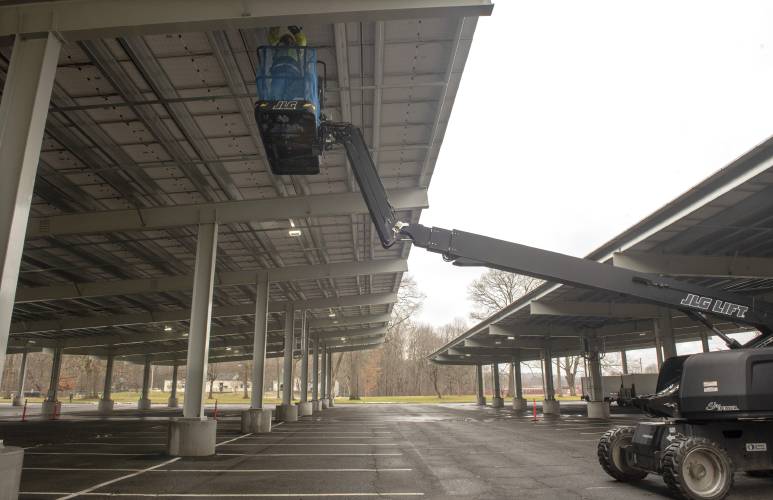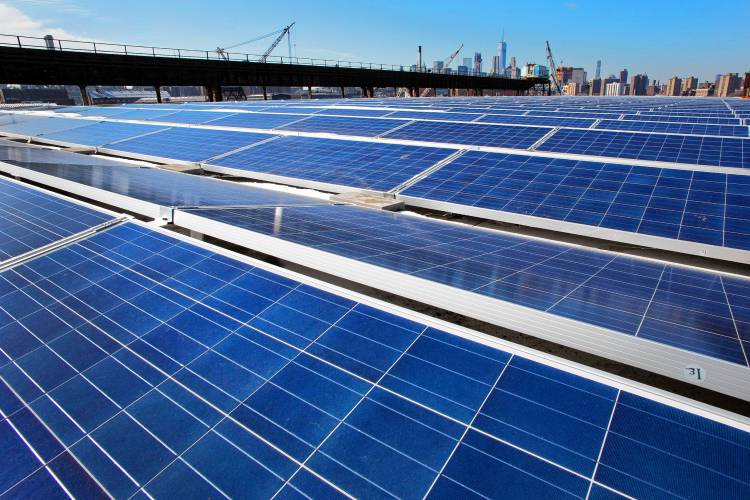Columnist Johanna Neumann: Reaping the rewards of rooftop solar
| Published: 04-17-2024 5:33 PM |
This week my boys and I are visiting my mom and stepdad for April break. Shortly after we arrived, they proudly gave us a tour of their new PV solar array, which they had installed on the south face of their home earlier this year. My stepdad, Rick, mentioned that the 30% tax credit made possible by the federal Inflation Reduction Act was a key driver in helping them go solar.
Over lunch, Rick walked me through the app on his phone where he tracks the power production of the solar panels and their household energy use. He shared how much more aware he’s become of their energy consumption since he started monitoring it. He’s finding himself turning off lights and powering down appliances that aren’t in use, pleased when he sees his energy-saving actions mirrored on his phone.
This is part of the power of rooftop solar. It gives individual people, like my mom and stepdad, a sense of ownership over their own energy future.
After decades of centralized power production burning fossil fuels, thanks to incredible technological progress, today we can power our lives with solar more affordably and efficiently than ever before. America has the potential to meet its energy needs many times over by tapping the power of the wind, the energy of the sun and the warmth of the earth. The sooner we tap that potential the better it will be for our health and our planet.
Solar power is particularly valuable when it produces energy right where we need it: on the rooftops of our homes and businesses. Although rooftop solar is a relatively small segment of our overall solar potential, it brings with it unique benefits that make it a resource we should be looking to maximize this decade.
For one, rooftop solar helps limit the amount of land we’ll need to commit to clean energy infrastructure. From folks wanting to preserve forests in Shutesbury to residents concerned about the impacts of utility-scale battery storage in Hadley, tensions around siting utility-scale renewable energy infrastructure continue to roil communities in Massachusetts and around the country. One way to avoid tensions around siting is to direct solar to rooftops and parking lots, where we can limit the amount of land needed for clean energy. When my colleagues and I analyzed California data, we found that every gigawatt of solar prevented the need for 5,200 acres of utility-scale solar.
Rooftop solar can also help communities become more resilient and self-reliant. When coupled with battery storage and incorporated into microgrids, rooftop solar can help households and communities weather hurricanes, extreme heat or destructive wildfires that are becoming more commonplace and powerful in a rapidly warming world.
Some of the most obvious places to put solar panels are the flat sun-kissed roofs of big box stores and warehouses. Massachusetts has more than 1,804 big box stores. Putting solar panels on the roofs of those buildings could generate enough electricity to power 134,329 average households. Our state also hosts more than 7,376 medium and large warehouses with more than 163 million square feet of rooftop area suitable for solar panels. Maximizing solar on warehouses could produce enough electricity to power 379,000 average households. And, of course, Massachusetts has a lot of free-standing homes, apartment buildings and industrial buildings that could host solar panels on their roofs as well. Every sunny roof without solar panels is a missed opportunity.
Article continues after...
Yesterday's Most Read Articles
 On The Ridge with Joe Judd: What time should you turkey hunt?
On The Ridge with Joe Judd: What time should you turkey hunt?
 Franklin Tech student welds artistic bench for French King Bridge
Franklin Tech student welds artistic bench for French King Bridge
 Formed 25,000 years ago, Millers River a historic ‘jewel’
Formed 25,000 years ago, Millers River a historic ‘jewel’
 Police report details grisly crime scene in Greenfield
Police report details grisly crime scene in Greenfield
 Authorities ID victim in Greenfield slaying
Authorities ID victim in Greenfield slaying
 ‘I have found great happiness’: The Rev. Timothy Campoli marks 50 years as Catholic priest
‘I have found great happiness’: The Rev. Timothy Campoli marks 50 years as Catholic priest
Massachusetts is making progress. We ranked 4th in the nation for growth of small-scale solar generation from 2012-2022, and generated enough electricity from small-scale solar in 2022 to power all the households in Boston and Somerville.
Despite this growth, we’re still just scratching the surface. As of 2022, we’ve tapped less than 11 percent of our state’s rooftop solar generation potential. State policy can help get us further along.
Massachusetts lawmakers are currently considering a goal to get to the equivalent of a million solar roofs statewide by 2030, as well as incentives for solar on roofs and parking lots, and cutting red tape for residential rooftop solar by switching to electronic or automated permitting to make going solar as easy, affordable, fast and hassle-free as possible.
Thanks to federal incentives, folks like my mom and step dad who grew up in the fossil-fuel era are enjoying the benefits of clean forms of energy. This is the decade where we should be deploying rooftop solar everywhere we can as fast as possible. And when we do, we’ll all reap the benefits.
Johanna Neumann of Amherst has spent the past two decades working to protect our air, water and open spaces, defend consumers in the marketplace and advance a more sustainable economy and democratic society. She can be reached at columnists@gazettenet.com.



 My Turn: A ruthless strategy that damages US
My Turn: A ruthless strategy that damages US Analee Wulfkuhle: Shores Ness a vote for Deerfield’s future
Analee Wulfkuhle: Shores Ness a vote for Deerfield’s future Byron Coley: Shores Ness for Select Board
Byron Coley: Shores Ness for Select Board Amy Tibbetts: Northfield residents deserve truth and clarity
Amy Tibbetts: Northfield residents deserve truth and clarity
